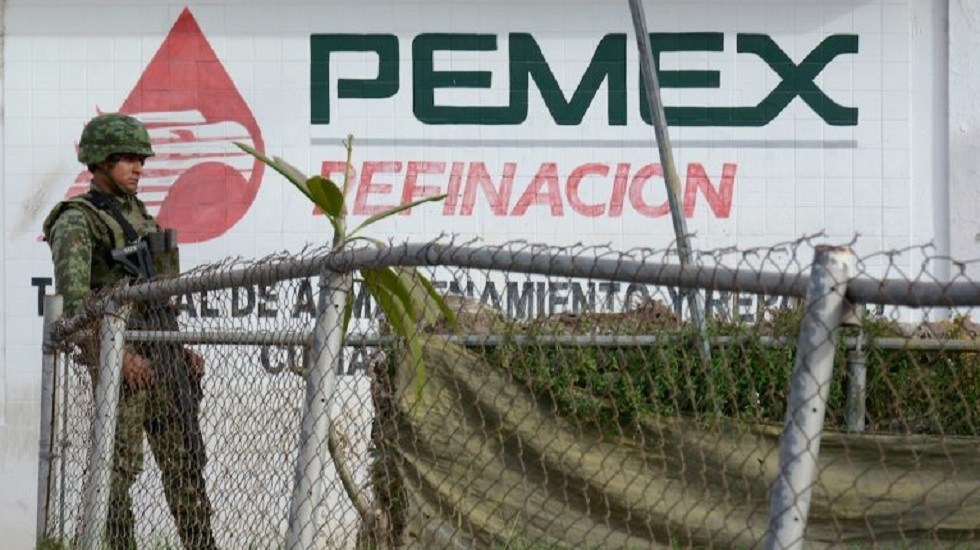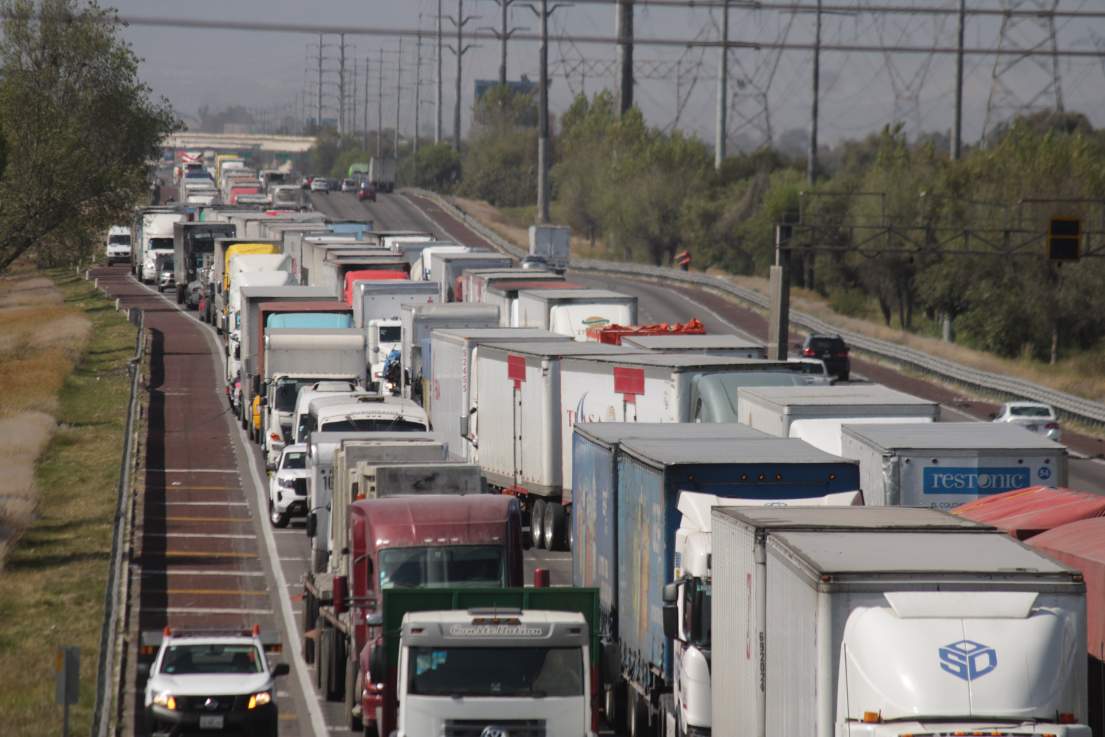Nacional
Fitch baja calificación de Pemex a BBB- con perspectiva negativa

CIUDAD DE MÉXICO, 29 DE ENERO. – La calificadora Fitch Ratings modificó la calificación de bonos de largo plazo en moneda extranjera de Pemex de BBB+ a BBB-.
Por otra parte, los bonos de largo plazo en moneda nacional también sufrieron una baja de calificación de AAA(mex) a AA(mex), con perspectiva negativa.
De acuerdo con Fitch Ratings, estos movimientos obedecen al deterioro del perfil crediticio de Pemex.
Aquí el comunicado íntegro del 29 de enero de Fitch Ratings en inglés:
Fitch Ratings has downgraded Petroleos Mexicanos’ (PEMEX) Long-Term Foreign- and Local-Currency Issuer Default Ratings (IDRs) to ‘BBB-‘ from ‘BBB+’ and its National Long-Term ratings to ‘AA(mex)’ from ‘AAA(mex)’. The Rating Outlook is Negative. These downgrades apply to approximately USD80 billion of notes outstanding and all national scale long-term issuances. Fitch has also affirmed PEMEX’s Short-Term ratings and all related nationally rated debt securities at ‘F1+(mex)’. A complete list of rating actions follows at the end of this press release.
Today’s downgrades reflect the continued deterioration of PEMEX’s standalone credit profile (SCP) to ‘CCC’ from the previous assessment of ‘B-‘ as a result of persisting negative FCF and material under-investment in the company’s upstream business. Fitch projects that PEMEX will have negative free cash flow of between USD3 billion to USD4 billion for both 2018 and 2019. This deficit is understated and Fitch estimates that it would be between USD12 billion to USD17 billion higher if PEMEX were investing at a level that would stabilize its production. Fitch also expects PEMEX to report a total debt-to-proved reserve (1P) of approximately USD15/boe as of yearend 2018, and for FFO adjusted leverage to continue exceeding 10x, which Fitch considers commensurate with a CCC rating category. PEMEX has been technically insolvent since 2009 by having a negative total equity balance.
PEMEX’s SCP deterioration to ‘CCC’ has led Fitch to lower its assessment of the government’s incentive to support the company to “strong” from “very strong”, which has resulted in a rating of two notches below the United Mexican States (UMS), in accordance with our Government-Related Entities (GRE) Criteria. Fitch continues to assess the government’s ownership and control of the company as “very strong” and its support track record as “moderate” due to the government’s very large extractions of cash from PEMEX in recent years. Fitch could further lower its assessment of government support if additional large transfers to the government are made coupled with persisting underinvestment and negative FCF. This could result in additional negative rating pressure. In Fitch’s view, the Mexican government’s recently announced support measure for PEMEX are not enough to offset the recent deterioration in the company’s SCP. During the past two months, the Mexican government announced, among other measures, a capital injection of MXN25 billion as well as a reduction of the government take that the company estimates could reduce transfers to the government by MXN11 billion in 2019 and grow to MXN66 billion by 2024.
The continued government inaction to stabilize the company’s SCP deterioration to ‘CCC’ prevents Fitch from assessing the incentives to support PEMEX as “very strong”; therefore, Fitch has revised its assessment for these factors to “strong”. The slow reaction to strengthen PEMEX’s SCP is an indication that the government has not recognized the viability of the company’s financial profile and/or the strategically important role the entity plays for the government and the country. Financial distress at PEMEX could disrupt the supply of liquid fuels in the entire country, which could have material social and economic consequences for Mexico. Mexico is a net importer of liquid fuels, and PEMEX relies on the import of basic oil products, including dry gas, petroleum products and petrochemicals to supply local demand. During 2018, PEMEX imported approximately 70% of the gasoline and diesel sold in Mexico. Financial distress at PEMEX might also have implications on the ability to raise financing of the government or other GREs within the country.
The Negative Outlook mirrors UMS’s sovereign Outlook (BBB+/Negative) and also reflects the potential for further deterioration of Pemex’s SCP to below ‘CCC’. Additional large fund transfers to the government could result in negative FCF generation, rising debt and prohibit sustainable capital reinvestment. The company’s FCF continues to be negative despite efforts to cut costs and Capex. Fitch expects PEMEX’s FFO Adjusted leverage to have been more than 10x at YE 2018 and total debt-to-proved reserves (1P) to have reached nearly USD15/bbl. Should the Mexican government fail to prevent PEMEX’s SCP from deteriorating below ‘CCC’, Fitch believes it will be a further indication the government views of PEMEX’s strategic importance for the country as less important and could result in further negative rating actions for PEMEX’s IDRs.
KEY RATING DRIVERS
Strong Government Linkage: Although Fitch’s assessment of the strength of the linkage between PEMEX and the government was revised downwards as a result of the SPC deterioration, Fitch continues to expect the government to ensure PEMEX maintains a robust liquidity position to service debt, which supports the material rating uplift from the SCP. PEMEX’s linkage to the Mexican government results from strong incentives to support the company given the socio-political and financial consequences a PEMEX default would have for the country. PEMEX is Mexico’s largest company and one of the government’s major sources of funds, historically contributing between 25% and 30% of government revenues.
Transfers Weaken SCP: PEMEX’s deteriorating SCP is primarily the result of excessive distributions to the government. The company contributions to Mexico have averaged approximately 10% of government revenues or approximately MXN500 billion (or USD26.7 billion) as of the last 12 months ended (LTM) Sept. 30, 2018. Transfers from PEMEX to the government remain high in relation to the company’s cash flow generation, and during the past five years transfers to the government averaged 45% of sales, or more than 80% of adjusted EBITDA. As a result, the company’s balance sheet has steadily weakened with a significant increase in debt and negative equity since year-end 2009. PEMEX’s debt lacks an explicit guarantee from the Mexican government.
Strategic Importance for Energy Security: Linkage to the sovereign stems from the company’s strategic importance in supplying liquid fuels to Mexico. A financial crisis at the oil company would have very strong socio-political consequences for Mexico as it may potentially disrupt the country’s liquid fuel supply. Mexico is a net importer of liquid fuels as a result of continued production decline. The country relies on PEMEX for virtually all the supply of gasoline and diesel, of which approximately two thirds come from imports. A financial crisis at PEMEX could also have very strong financial consequences for the Mexican government and other GREs, especially regarding their access to funding.
Moderate Government Support: Fitch considers Mexico’s support of PEMEX moderate, and it reflects modest capital injections, support for pension liabilities and marginal tax reductions. This moderate support assessment reflects the high level of transfers from the company to the government. Fitch expects the government to execute more meaningful supportive actions when needed. In its 2019 budget, the Mexican government announced a capital injection into PEMEX of MXN25 billion, which compares very unfavorably with the MXN520 billion of government oil revenues budgeted for the year. During the past two months, the Mexican government announced, among other measures, a capital injection of MXN25 billion as well as a reduction of the government take that the company estimates could reduce transfers to the government by MXN11 billion in 2019 and grow to MXN66 billion by 2024. In the past, the company has also received other capital injections for different purposes, and Fitch expects the Mexican government to continue ensuring PEMEX has strong liquidity position to service debt.
Deteriorating Underlying Credit Quality: PEMEX’s SPC is in line with a Long-Term IDR of ‘CCC’ if it were not owned by the state and if the government were not to provide financial support. PEMEX’s SCP could continue deteriorating if the Mexican government continues extracting large amounts of funds from PEMEX, resulting in weak FFO, negative FCF and increasing leverage. The company’s SCP could also continue deteriorating as a result of a change in strategy that materially increases downstream capex or affects domestic realization prices, especially if at the expense of lowering upstream Capex and/or increasing leverage. During the LTM ended Sept. 30, 2018, PEMEX reported an adjusted EBITDA before net pension expenses of USD27.6 billion and FFO of USD2.1 billion, while total debt amounted to USD106 billion.
Weak Post-tax Credit Metrics: Although PEMEX reports moderately solid pre-tax credit metrics, its post-tax credit protection metrics are weak as a result of high transfers to the federal government. As of the LTM ended Sept. 30, 2018, PEMEX reported a Fitch calculated FFO adjusted leverage of roughly 12.5x. Fitch expects FFO leverage to have recovered moderately in 2018 under its price deck assumptions to approximately 10x and deteriorate thereafter. PEMEX’s total debt-to-proved reserves (1P) have deteriorated to around USD15/boe from USD9.2/boe in 2015.
Capex Cuts Reduce Production: Fitch expects production and hydrocarbon reserves to continue declining over the medium term and to potentially stabilize after three to five years as current Capex is insufficient to replenish reserves. Fitch estimates PEMEX will require an annual capex of around USD13 billion to USD18 billion to replenish reserves, this is based on a finding, development and acquisition cost (FD&A) estimate of between USD13/boe to USD18/boe. PEMEX’s exploration and production capex for 2017 and 2018’s budget of USD4.5 billion and USD4.3 billion, respectively, was not enough to replenish annual production of approximately 1 billion boe. Fitch estimates production could decline 5% per year over the next few years and stabilize thereafter. Recent discoveries, namely Ixachi, which added an estimated 1.3bn boe of 3P reserves, may help offset somewhat the company’s production and reserve decline but are not enough to reverse the declining trend.
Weak Corporate Governance: Fitch considers PEMEX’s corporate governance weak given the continued high level of government interference in the company’s strategy, financing and management changes with changes in administration. Current proposed legislation intended to amend Mexico’s hydrocarbon law (PEMEX Law) in order to transfer greater power to the company’s management from its board of directors (BoD) could increase control over the company by Mexico’s executive branch. Under the current PEMEX Law, the president of Mexico appoints the company’s CEO, and all other positions are approved by the BoD’s independent human resources committee. The changes proposed to the law would allow management to appoint staff up to two levels below the CEO. The initiative also proposes, among other things, to transfer PEMEX’s human resources control to management from the BoD and to have management present for approval the company’s strategic direction and pricing decisions
DERIVATION SUMMARY
PEMEX’s linkage to the sovereign compares unfavorably with that of Petrobras (BB-/Stable), Ecopetrol (BBB/Stable) Enap (A/Stable) and Petroperu (BBB+/Stable). All of PEMEX’s regional peers have strong linkage to their respective sovereigns as a result of strong government support. In Fitch’s view, all governments in the region, except for Mexico, have implemented different measure to ensure the standalone credit profiles (SCPs) of their respective national oil and gas companies (NOCs) remains viable in the long term.
PEMEX’s ratings continue to reflect its close, albeit deteriorating, linkage to the government of Mexico and the company’s fiscal importance to the sovereign and strategic importance to the country. PEMEX’s ratings also reflect the company’s competitive pre-tax cost structure, national and export-oriented profile, sizable hydrocarbon reserves and its strong domestic market position. The ratings are constrained by PEMEX’s substantial tax burden, high leverage, significant unfunded pension liabilities, large capital investment requirements, negative equity and exposure to political interference risk.
Fitch views PEMEX’s SCP as commensurate with a ‘CCC’ rating, which is five notches below Petrobras’ SCP of ‘BB-‘ and nine notches below Ecopetrol’s SCP of ‘BBB’. These differences are primarily due to PEMEX’s weaker capital structure and increasing debt and leverage trajectory. PEMEX’s SCP of ‘CCC’ reflects the company’s burdensome transfers to Mexico’s federal government; its large and increasing financial debt balance when compared with 1P reserves; an FFO Adjusted leverage in excess of 10x; and its decreasing production and reserves trend. In comparison, Ecopetrol and Petrobras have significantly strengthened their capital structure, and as of Sept. 30, 2018, their FFO Adjusted Leverage was 1.6x and 3.8x, respectively.
KEY ASSUMPTIONS
Fitch’s Key Assumptions Within Our Rating Case for the Issuer
–Average West Texas Intermediate (WTI) crude prices of USD57.5/bbl in 2019 and USD55/bbl in the long term:
–Capex cuts implemented in 2017 continue for the medium term;
–Production declines by 5% over the next few years;
–PEMEX will receive necessary support from the government to ensure adequate liquidity and debt service payments:
–Mexico lowers cash taxes for 5% of the company’s production in half per year over the next five years, resulting in a decrease of approximately a 12% in government take from the existing tax scheme.
RATING SENSITIVITIES
Developments That May, Individually or Collectively, Lead to Positive Rating Action
Although not expected in the short term, a rating upgrade or Outlook stabilization could result from:
–An upgrade of Mexico’s sovereign ratings;
–An irrevocable guarantee from Mexico’s government sovereign of sustainably more than 75% of PEMEX’s debt;
–A material capitalization of PEMEX together with a business plan that results in neutral to positive FCF through the cycle while implementing after a sustainable upstream capex that is sufficient to replace 100% of reserve and stabilize production;
–A sustainable FFO Adjusted Leverage below 5x.
Developments That May, Individually or Collectively, Lead to Negative Rating Action
A negative rating action could be triggered by any combination if the following factors:
–A downgrade of the sovereign’s rating that is not driven by the materialization of PEMEX related contingent liabilities related to PEMEX;
–A sustain deterioration of PEMEX’s financial flexibility coupled with government inaction to support liquidity. This could result from continue negative FCF and/or a material reduction of the company’s cash on hand, credit facilities and/or restricted capital markets access.
–An FFO Adjusted Leverage materially above 8x and total debt to 1P reserve significantly higher than USD15/boe:
–A continue deterioration of the company’s SCP to below the current ‘CCC’ assessment, which could result if the company fails to stabilize production and continues with unsustainable reserves replacement ratios and negative FCF.
LIQUIDITY
Market Dependent Liquidity: Liquidity is supported by cash on hand of approximately USD4.7 billion as of Sept. 30, 2018 and approximately USD6.7 billion of undrawn credit facilities. PEMEX’s liquidity is also supported by its proven track record of access to international debt capital markets. During the first three quarters of 2018, the company raised approximately USD16 billion of debt. The proceeds of these issuances and liability management operations were used to finance capital investments, repay debt and for general corporate purposes, which include transfers to the federal government. The debt amortization schedule is balanced, with somewhat manageable short-term debt maturities. During the past few years PEMEX successfully implemented several liability management operations in order to extend its amortization profile. As of Sept. 30, 2018, short-term debt amounted to approximately USD9.5 billion.
Liquidity is further bolstered by a robust pre-tax cash flow generation supported by a competitive operational cost structure. The company’s available committed revolving credit lines as of September 2018 amounted to USD6.7 billion and MXN23.5 billion, of which USD450 million and MXN13,500 million, respectively are drawn down. Fitch estimates operating cash costs to be less than USD20 per barrels of oil equivalent (boe) as of 2018YE, including interest costs and full allocation of administrative expenses to the upstream business.
PEMEX’s liquidity ratio is approximately 0.9x, as measured by cash and equivalents plus undrawn credit facilities to short-term debt minus FCF divided by short-term debt. Although PEMEX had enough cash on hand plus undrawn facilities to cover short term debt amortizations as of Sept. 2018, the company is expected to continue having a negative FCF in 2019, which could drive its liquidity ratio below 1x. According to the government’s financing plan for 2019 (Plan Anual de Financiamento 2019), PEMEX’s financial needs for this year will be MXN197 billion due to a negative financial balance of USD3.3 billion (MXN65.4 billion) and debt amortization of USD6.6 billion (MXN131.6 billion). The debt is comprised internal debt of MXN 46.7 billion and foreign market debts of MXN84.9 billion.
FULL LIST OF RATING ACTIONS
Fitch has taken the following rating actions:
PEMEX
–Long-Term Foreign Currency IDR downgraded to ‘BBB-‘ from ‘BBB+’; Outlook Negative;
–Long-Term Local-Currency IDR downgraded to ‘BBB-‘ from ‘BBB+’; Outlook Negative;
–National Long-Term Rating downgraded to ‘AA(mex)’ from ‘AAA(mex)’; Outlook to Negative from Stable;
–National Short-Term Rating affirmed at ‘F1+(mex)’;
–Notes outstanding in foreign currency downgraded to ‘BBB-‘ from ‘BBB+’;
–Notes outstanding in local currency downgraded to ‘BBB-‘ from ‘BBB+’;
–National scale debt issuances downgraded to ‘AA(mex)’ from ‘AAA(mex)’.
Guarde este número y envíe un mensaje por WhatsApp con la palabra ALTA al 55-64-41-15-90 para recibir las noticias más importantes
FITCH RATINGSPEMEX

Nacional
PROPONEN REFORMAS PARA COMBATIR EL BULLYING EN LAS ESCUELAS

Palacio Legislativo de San Lázaro, 07 de diciembre de 2025.— La diputada Ana Isabel González González (PRI) presentó una iniciativa de reforma a la Ley General de Educación que busca enfrentar el bullying como una responsabilidad compartida entre Estado, padres de familia y autoridades educativas. La propuesta adiciona los artículos 16 Bis, 16 Ter, 16 Quáter y 16 Quinquies, con el objetivo de garantizar el derecho de niñas, niños y adolescentes a una vida libre de violencia.
La iniciativa establece que el Estado deberá implementar programas y políticas públicas que prioricen la integridad y el bienestar de los estudiantes. Se define el bullying como toda forma de violencia física, verbal, psicológica o digital ejercida de manera reiterada, con el propósito de intimidar, excluir o dañar.
Un aspecto central de la propuesta es la participación obligatoria de padres y tutores en programas de prevención y capacitación sobre convivencia escolar. Además, se prevé que, en caso de reincidencia, se apliquen medidas proporcionales: desde amonestaciones y cursos de parentalidad positiva, hasta multas económicas y canalización a instancias de procuración de justicia para evaluar responsabilidades.
La diputada enfatizó que las sanciones no buscan criminalizar a los menores, sino garantizar el interés superior de la niñez y fomentar un entorno educativo seguro. La iniciativa fue turnada a la Comisión de Educación para su análisis y dictamen.
En su exposición de motivos, González González subrayó que el acoso escolar es una de las principales causas de deserción en la educación básica, con graves consecuencias psicológicas y un incremento en la violencia juvenil. Por ello, consideró urgente cerrar vacíos legales y dotar a docentes y estudiantes de herramientas para identificar y enfrentar el acoso.
Con esta propuesta, se busca consolidar un marco regulatorio que proteja la salud emocional y el desarrollo integral de la niñez mexicana.
Fuente: 5to Poder Agencia de Noticias

Nacional
BLOQUEO NACIONAL DE TRANSPORTISTAS Y CAMPESINOS PARALIZA CARRETERAS EN 25 ESTADOS

México enfrenta este martes una de las movilizaciones más amplias de los últimos años, luego de que transportistas y campesinos iniciaran un bloqueo nacional que afecta carreteras y autopistas en al menos 25 estados de la República. La protesta, organizada por diversas agrupaciones, tiene como objetivo exigir al gobierno federal mayor seguridad en las vías de comunicación y mejores condiciones para el campo mexicano, un sector que, según los manifestantes, ha sido relegado en materia de apoyos y programas de desarrollo.
Desde las primeras horas de la mañana, se reportaron cierres en tramos estratégicos como la México–Querétaro, México–Cuernavaca, Chamapa–Lechería, así como autopistas del norte y sur del país, generando largas filas de vehículos y retrasos en el transporte de mercancías. Los bloqueos han provocado que miles de ciudadanos queden varados, mientras empresas alertan sobre el impacto inmediato en la distribución de alimentos, combustibles y bienes de consumo.
Los líderes del movimiento señalaron que la protesta no busca confrontación, sino visibilizar la crisis que enfrentan los sectores productivos. Sin embargo, en algunos puntos se registraron tensiones entre automovilistas y manifestantes, lo que obligó a la Guardia Nacional a desplegar operativos para garantizar el paso de vehículos de emergencia y evitar incidentes mayores. Autoridades federales han llamado al diálogo, pero los inconformes advierten que las acciones podrían intensificarse si no se establecen mesas de negociación inmediatas con la Secretaría de Gobernación y la Secretaría de Agricultura.
El impacto económico de la protesta comienza a sentirse en mercados regionales, donde comerciantes reportan retrasos en la llegada de productos básicos. Expertos advierten que, de prolongarse, el bloqueo podría traducirse en pérdidas millonarias para el sector logístico y agroalimentario. Mientras tanto, ciudadanos expresan su malestar por las afectaciones en sus traslados cotidianos, reclamando soluciones rápidas y efectivas.
La protesta nacional refleja el creciente malestar social en torno a la inseguridad y la falta de apoyos al campo, dos problemáticas que, de acuerdo con los manifestantes, requieren atención urgente para garantizar la estabilidad y el desarrollo del país.
Fuente: 5to Poder Agencia de Noticias































